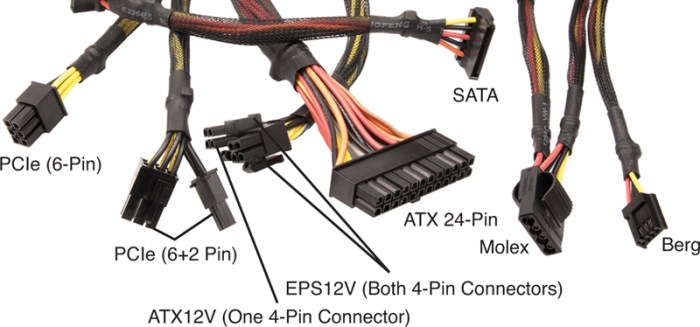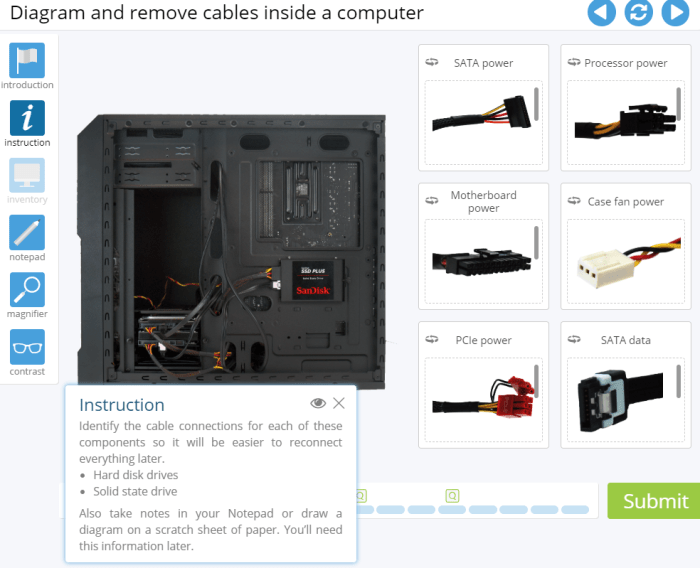Embark on an educational odyssey with Advanced Hardware Lab 1-2: Identify Power Supply Connectors, where you will delve into the intricacies of powering your electronic creations. This comprehensive guide will equip you with the knowledge and skills necessary to confidently navigate the realm of power supply connectors, ensuring seamless functionality and optimal performance for your hardware endeavors.
Power Supply Connector Identification

Power supply connectors provide the electrical connection between a power supply and various components within a computer system. These connectors deliver power to critical components such as the motherboard, graphics card, and storage devices, ensuring the proper functioning of the system.
There are several types of power supply connectors, each designed for a specific purpose and component. The most common types include:
- 24-pin ATX connector: Connects the power supply to the motherboard, providing power to the CPU, memory, and other essential components.
- 8-pin EPS connector: Provides additional power to the motherboard, typically used for high-performance systems or overclocking.
- 6+2-pin PCIe connector: Connects to graphics cards, providing power for their operation.
- SATA connector: Powers SATA storage devices such as hard drives and solid-state drives.
- Molex connector: An older type of connector still used for legacy devices or peripherals.
Advanced Hardware Lab Setup
An advanced hardware lab is a specialized facility designed for research, development, and testing of computer hardware and electronic systems. It provides a controlled environment with the necessary infrastructure and equipment to conduct complex hardware experiments and projects.
The setup of an advanced hardware lab typically includes:
- Workstations with high-performance computers and specialized software.
- Power supplies, oscilloscopes, and other test and measurement equipment.
- Circuit boards, microcontrollers, and other hardware components.
- Dedicated electrical and cooling systems to ensure stable and reliable operation.
- Safety protocols and procedures to minimize risks and hazards.
Power Supply Connector Testing

Testing power supply connectors is crucial to ensure the reliability and proper functioning of computer systems. It involves verifying the electrical continuity, voltage levels, and pinout configuration of the connectors.
The testing process typically involves the following steps:
- Visual inspection for any physical damage or defects.
- Continuity testing using a multimeter to check for open circuits.
- Voltage measurement to verify the correct voltage levels are present on the pins.
- Pinout verification using a breakout board or adapter to ensure the proper alignment and connection of the pins.
Troubleshooting Power Supply Connector Issues
Power supply connector issues can manifest in various ways, such as system instability, component malfunctions, or complete system failure. Troubleshooting these issues requires a systematic approach to identify the root cause.
Common causes of power supply connector problems include:
- Loose or disconnected connectors.
- Bent or damaged pins.
- Incorrect pinout configuration.
- Power supply failure.
Troubleshooting techniques involve:
- Checking the physical connections and ensuring they are secure.
- Inspecting the pins for any damage or misalignment.
- Using a multimeter to test the continuity and voltage levels.
- Replacing the power supply or connector if necessary.
Advanced Hardware Lab Safety

Working in an advanced hardware lab poses potential hazards and risks due to the presence of high-voltage equipment, electrical currents, and specialized machinery. Therefore, it is essential to prioritize safety to prevent accidents and injuries.
Safety guidelines include:
- Always wear appropriate personal protective equipment (PPE) such as anti-static wrist straps, safety glasses, and gloves.
- Follow established safety protocols and procedures.
- Be aware of potential electrical hazards and avoid touching exposed wires or components.
- Use proper grounding techniques to prevent electrostatic discharge (ESD).
- Keep the lab clean and organized to minimize clutter and tripping hazards.
Power Supply Connector Design: Advanced Hardware Lab 1-2: Identify Power Supply Connectors

Power supply connectors are designed to meet specific electrical and mechanical requirements, ensuring reliable power delivery and compatibility with various components. The design considerations include:
- Pin count and configuration to match the power requirements of the connected device.
- Materials and construction to withstand high currents and temperatures.
- Durability and longevity to ensure a long service life.
- Compliance with industry standards and safety regulations.
Advanced power supply connector designs incorporate innovative features such as:
- High-current capabilities for demanding applications.
- Modular designs for flexibility and scalability.
- Enhanced safety features to prevent accidental disconnections.
- Compact and space-saving designs.
Q&A
What are the common types of power supply connectors?
ATX, EPS, PCIe, SATA, Molex
How can I identify a power supply connector?
Refer to the visual guide or table provided in the lab manual.
What are the safety precautions for working with power supply connectors?
Always wear anti-static wrist straps, discharge capacitors before handling, and follow proper grounding procedures.